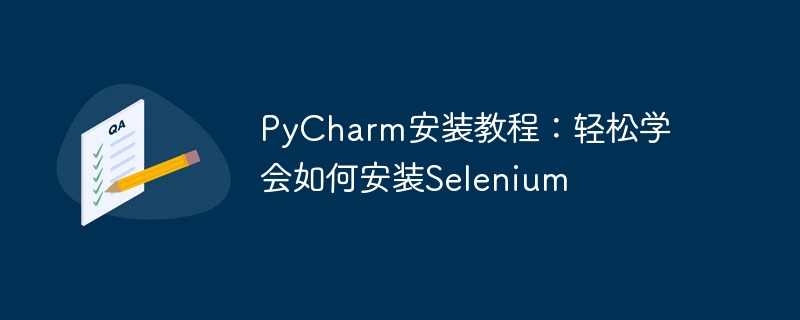Home >Backend Development >Python Tutorial >Learn to install Selenium easily using PyCharm: PyCharm installation and configuration guide
Learn to install Selenium easily using PyCharm: PyCharm installation and configuration guide
- WBOYWBOYWBOYWBOYWBOYWBOYWBOYWBOYWBOYWBOYWBOYWBOYWBOriginal
- 2024-01-04 21:48:101133browse

PyCharm installation tutorial: Easily learn how to install Selenium, need specific code examples
As Python developers, we often need to use various third-party libraries and Tools to complete project development. Among them, Selenium is a very commonly used library for automated testing and UI testing of web applications. As an integrated development environment (IDE) for Python development, PyCharm provides us with a convenient and fast way to develop Python code. So how to install Selenium in PyCharm? This article will introduce you to the detailed installation steps and provide specific code examples.
Step One: Download and Install PyCharm
First, we need to download and install PyCharm. On the official website (https://www.jetbrains.com/pycharm/), you can find the free Community Edition and the paid Professional Edition. Select the appropriate version to download according to your needs, and then install it according to the default installation steps.
Step 2: Create a Python project
After the installation is complete, start PyCharm and create a new Python project. Click "File"->"New Project", then select the name and location of the project according to the prompts, and finally click the "Create" button.
Step 3: Configure the Python interpreter
After creating the project, we need to configure the Python interpreter. Click "File"->"Settings", and then select "Project"->"Project Interpreter" in the pop-up settings dialog box. Click the gear icon in the upper right corner, select the "Add" button, select your Python interpreter in the pop-up dialog box, and then click the "OK" button to save the configuration.
Step 4: Install the Selenium library
In the PyCharm project, we can use Python's package management tool pip to install third-party libraries. Click the "Terminal" tab, open the command line terminal, and enter the following command in the command line to install the Selenium library:
pip install selenium
After the command is executed, the Selenium library has been installed successfully.
Step 5: Download and install the browser driver
Selenium needs to use the browser driver to control the browser for automated testing. Select the appropriate driver based on the browser you are using and download it locally. For example, if you are using the Chrome browser, you can find the corresponding driver download link on the official Chrome website (https://sites.google.com/a/chromium.org/chromedriver/downloads).
After decompressing the downloaded driver, add the folder path where it is located to the system environment variable. This way, Selenium can find and use the driver.
Step 6: Write sample code
In the PyCharm project, we can create a Python file and then write sample code to test whether the Selenium installation is successful. The following is a simple sample code:
from selenium import webdriver
# 创建一个Chrome浏览器实例
driver = webdriver.Chrome()
# 打开一个网页
driver.get("https://www.baidu.com/")
# 查找页面上的元素,并进行操作
input_element = driver.find_element_by_id("kw")
input_element.send_keys("Selenium")
button_element = driver.find_element_by_id("su")
button_element.click()
# 关闭浏览器
driver.quit()The above sample code uses Selenium's webdriver module to create a Chrome browser instance, then visits the Baidu homepage and enters the keyword "Selenium" in the search box. Finally simulate clicking the search button. You can try to run this code. If it can be executed normally and you see the corresponding operation results in the browser, Selenium has been successfully installed and configured.
Summary:
Through the introduction of this article, we have learned how to install the Selenium library in PyCharm, and provided specific code examples to test whether the installation is successful. I hope this article will help you learn how to install Selenium and use PyCharm to develop Python code. In the meantime, I wish you success in project development using Selenium and PyCharm!
The above is the detailed content of Learn to install Selenium easily using PyCharm: PyCharm installation and configuration guide. For more information, please follow other related articles on the PHP Chinese website!

